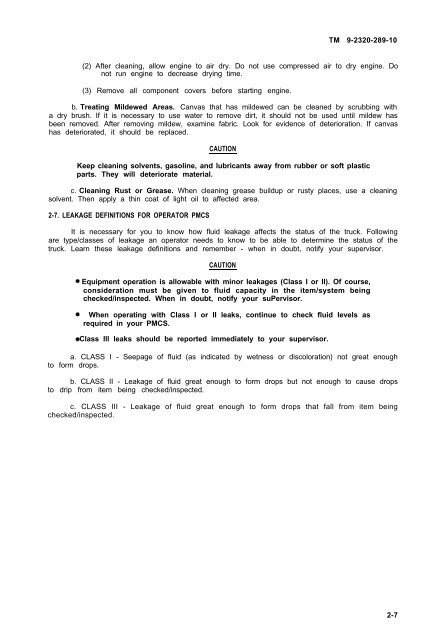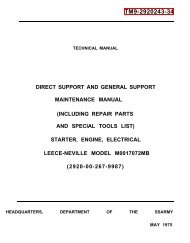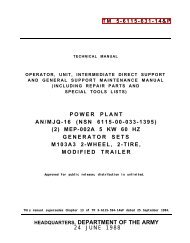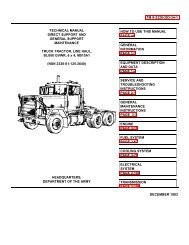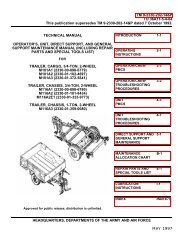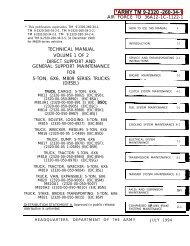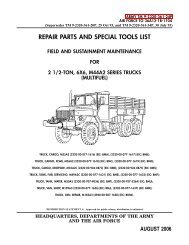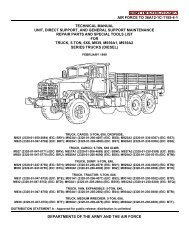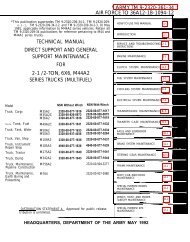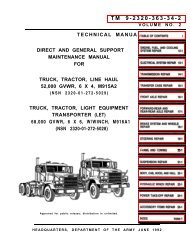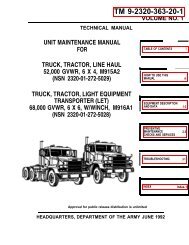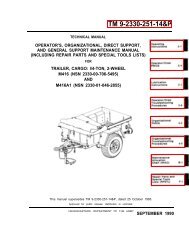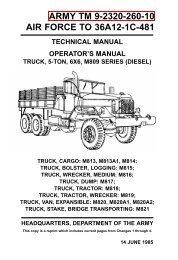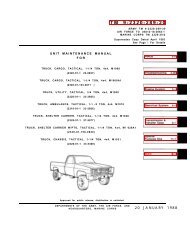TM 9-2320-289-10.pdf
TM 9-2320-289-10.pdf
TM 9-2320-289-10.pdf
You also want an ePaper? Increase the reach of your titles
YUMPU automatically turns print PDFs into web optimized ePapers that Google loves.
<strong>TM</strong> 9-<strong>2320</strong>-<strong>289</strong>-10<br />
(2) After cleaning, allow engine to air dry. Do not use compressed air to dry engine. Do<br />
not run engine to decrease drying time.<br />
(3) Remove all component covers before starting engine.<br />
b. Treating Mildewed Areas. Canvas that has mildewed can be cleaned by scrubbing with<br />
a dry brush. If it is necessary to use water to remove dirt, it should not be used until mildew has<br />
been removed. After removing mildew, examine fabric. Look for evidence of deterioration. If canvas<br />
has deteriorated, it should be replaced.<br />
CAUTION<br />
Keep cleaning solvents, gasoline, and lubricants away from rubber or soft plastic<br />
parts. They will deteriorate material.<br />
c. Cleaning Rust or Grease. When cleaning grease buildup or rusty places, use a cleaning<br />
solvent. Then apply a thin coat of light oil to affected area.<br />
2-7. LEAKAGE DEFINITIONS FOR OPERATOR PMCS<br />
It is necessary for you to know how fluid leakage affects the status of the truck. Following<br />
are type/classes of leakage an operator needs to know to be able to determine the status of the<br />
truck. Learn these leakage definitions and remember - when in doubt, notify your supervisor.<br />
CAUTION<br />
Equipment operation is allowable with minor leakages (Class I or II). Of course,<br />
consideration must be given to fluid capacity in the item/system being<br />
checked/inspected. When in doubt, notify your suPervisor.<br />
When operating with Class I or II leaks, continue to check fluid levels as<br />
required in your PMCS.<br />
Class Ill leaks should be reported immediately to your supervisor.<br />
a. CLASS I - Seepage of fluid (as indicated by wetness or discoloration) not great enough<br />
to form drops.<br />
b. CLASS II - Leakage of fluid great enough to form drops but not enough to cause drops<br />
to drip from item being checked/inspected.<br />
c. CLASS III - Leakage of fluid great enough to form drops that fall from item being<br />
checked/inspected.<br />
2-7


